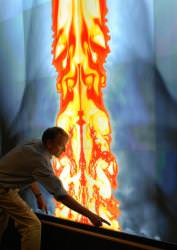When astronomers first made the connection between asteroid impacts and extinction events on Earth, it was kind of frightening. There are hundreds of thousands of those things out there zipping around! But dedicated asteroid hunters have located many of the largest planet smashers, and new programs are in the works to find the rest. But now it seems that even the smaller asteroids could be more destructive than previously believed.
Almost 100 years ago, something detonated in the atmosphere above Tunguska, Siberia, flatting the forest. Had it struck a populated area, the results would have been disastrous.
But now researchers have simulated the kind of spacerock that caused the Tunguska explosion. And here’s the bad news: it was probably a much smaller object than previously believed.
“The asteroid that caused the extensive damage was much smaller than we had thought,” says Sandia principal investigator Mark Boslough of the impact that occurred June 30, 1908. “That such a small object can do this kind of destruction suggests that smaller asteroids are something to consider. Their smaller size indicates such collisions are not as improbable as we had believed.”
Since smaller asteroids are more likely to hit the Earth than larger objects, we might want to get a little more concerned about the risks.
A new supercomputer simulation recreated the kind of fireball that could have caused the Tunguska explosion. They took into account how winds travel along the topography of the ground, and the health of the forest to see how easily the trees would be blown down.
What was originally believed to be a 10-20 megaton explosion was probably only 3-5 megatons. So it took a much smaller object to create the devastation in Tunguska.
The researchers didn’t actually suggest a new size for the object, estimating that sounds complicated. “It depends on the speed and whether it’s porous or nonpourous, icy or waterless, and other material characteristics.”
Original Source: Sandia News Release


Can you point out some of these upcoming asteroid monitoring programs?
Thanks!
What is the picture of? Looks more like art than an asteroid… Is that supposed to be a picture of the Tunguska Event?
This dovetails nicely with the recent discoveries of the Holocene Impact Group, who postulate that major mega-tsunami-causing impacts have happened as often as every 1000 years in the past 10000 years, wiping out coastlines hundreds of miles inland in a matter of hours. They have found compelling evidence of these events all over the coastlines of the world, composed of unstratified seafloor sediment deposits as high as 600 feet tall. The recent tsunami in Indonesia was miniscule in comparison. Science is reluctantly grasping how real, and recent, this threat is.
On a related note:
Recently Discovered Asteroid Could Hit Mars in January
link to full story:
http://neo.jpl.nasa.gov/news/news151.html